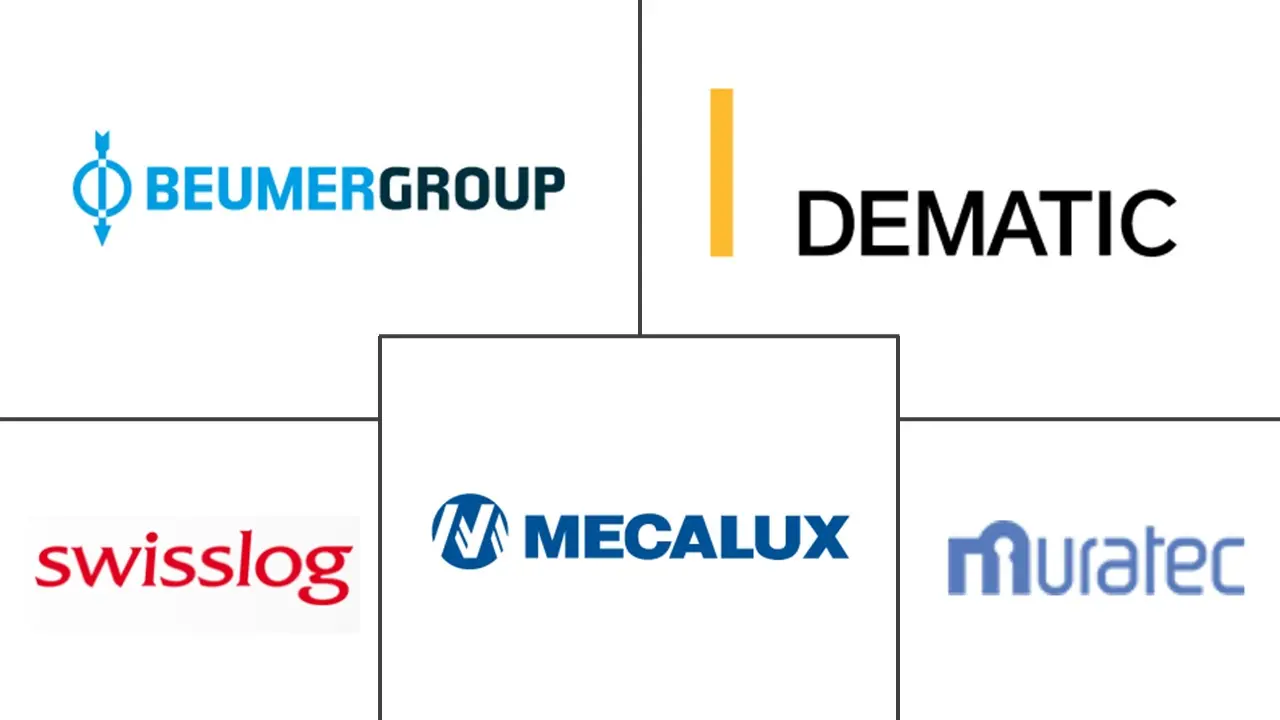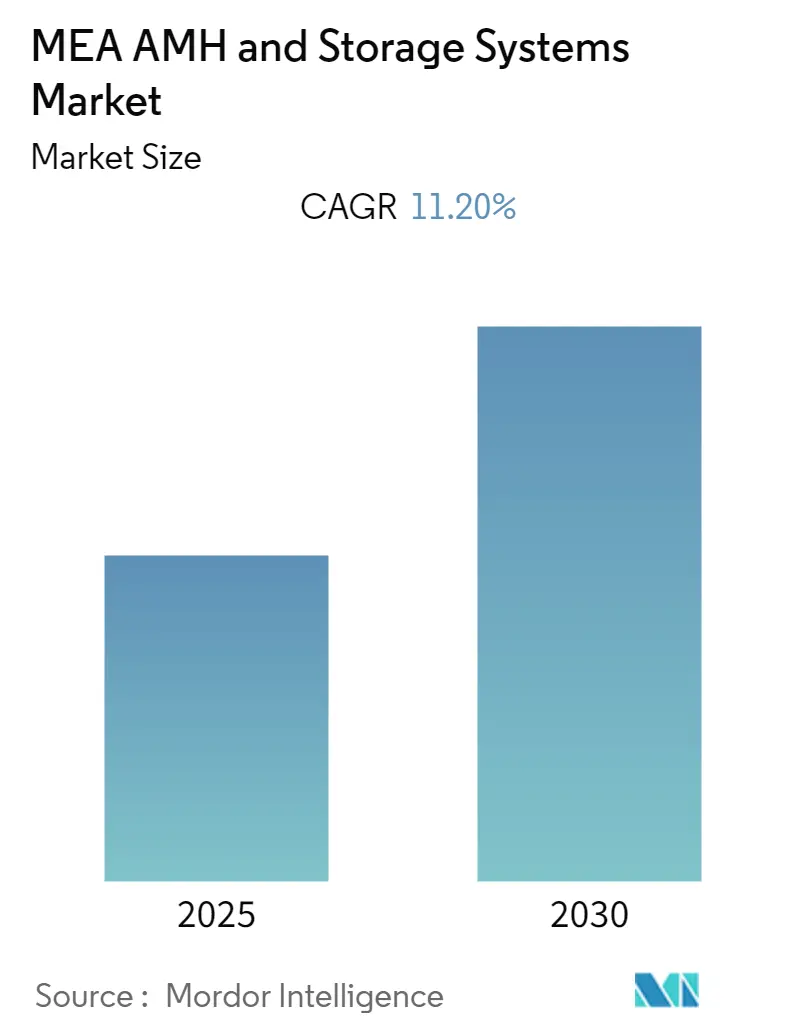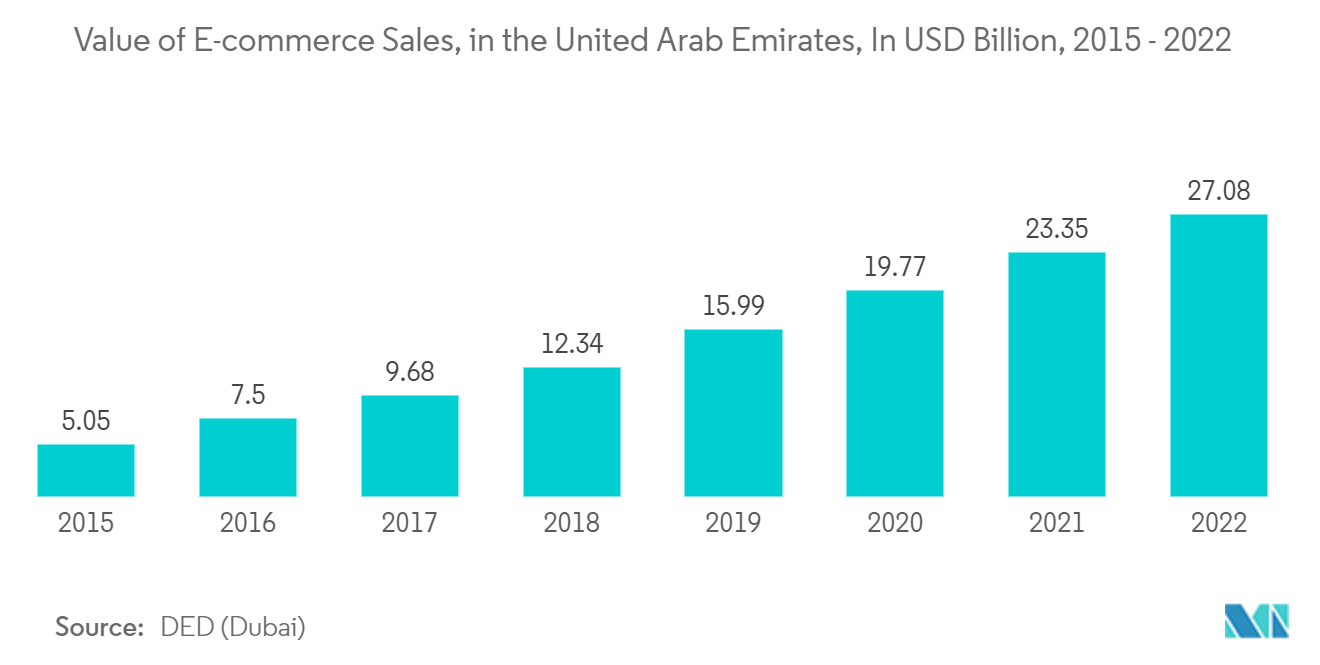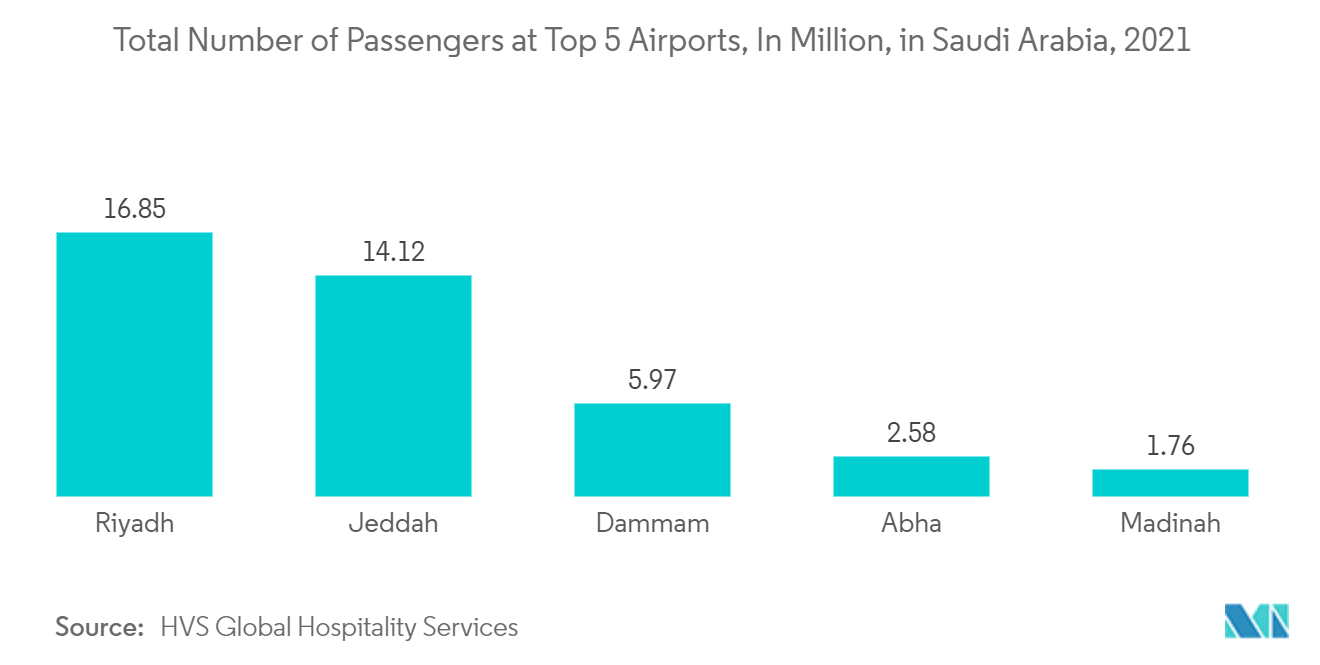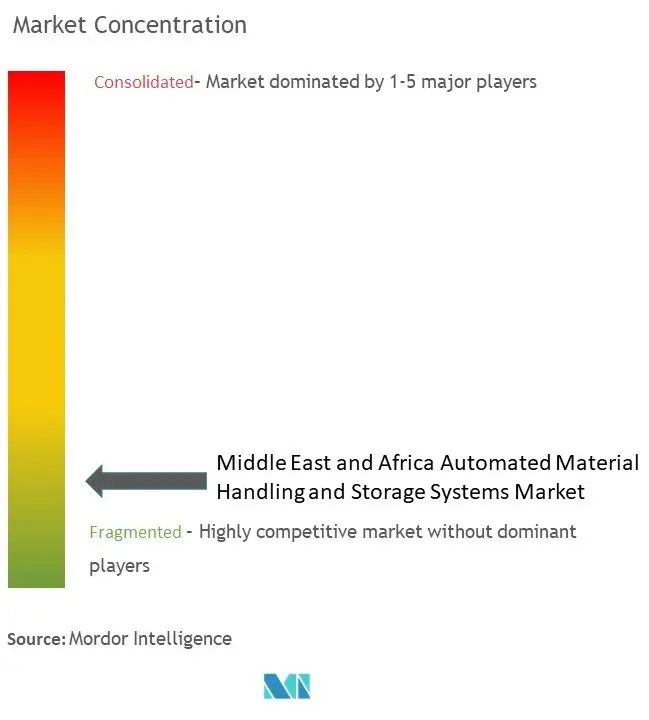MEA Automated Material Handling and Storage Systems Market Analysis
The MEA AMH and Storage Systems Market is expected to register a CAGR of 11.2% during the forecast period.
- The market is driven by trends caused by countries adopting technology 4.0 and IoT. Using robotics, industry 4.0 is revolutionizing material handling. In warehouses and distribution facilities, robotics has become more prevalent. In addition to picking and packaging orders, robots can be employed for loading and unloading trucks, and even cleaning the warehouse floor. Workplace accuracy and productivity can both be enhanced by robotics. Robots can also help companies save money by reducing the amount of manual work necessary. Industry 4.0 also has an impact on material handling using artificial intelligence. AI-powered robots are faster and more precise at picking orders than people. Additionally, they can use machine learning to route orders efficiently through the warehouse.
- IoT significantly reduces the cost and time needed for AGV/AMR maintenance. AGVs can be remotely monitored by maintenance personnel, who are only called in when problems emerge, eliminating the need for routine maintenance visits. Additionally, because the devices are operated by sophisticated software, cloud-based apps can control them wirelessly. Instructions can be transmitted remotely, and technical problems are easily fixed. As a result, maintenance is simple and affordable.
- E-commerce has been growing rapidly over the last few years. Many companies have moved from physical retail to online to better cater to consumer requirements. Major companies in the region have invested in technology to provide reliable consumer service.
- The COVID-19 pandemic complicated the situation of automation adoption in various sectors. It changed the standard operating procedure by bringing in unique challenges of social distancing and contactless operation. Organizations were forced to limit their workforce and deal with the increasing demand. In the post-pandemic era, cleaning public spaces is a difficult problem. The usage of UV-C light has proven to be a non-intrusive solution to this problem. However, UV light can harm a person's skin. AMRs with UV-C lamps installed can move independently through a defined region. Robots can navigate maps made by mobile apps using waypoints. The robots then proceed to clean the area while following the waypoints. When the battery is low, the robots also find the charging station without human assistance. Such use cases are anticipated to offer lucrative opportunities for the growth of the studied market.
- The equipment used for material handling (such as robotic arms) and storage systems has been highly cost-intensive. Automated storage and retrieval systems (ASRS) have been found to cost higher than the typical material-handling equipment in the market studied. Automated cranes also need a high amount of infrastructure to sustain the product.
MEA Automated Material Handling and Storage Systems Market Trends
Growing E-commerce in Middle East and Africa is Expected to Drive the Market
- The Middle East is one of the fastest-growing e-commerce markets globally, with one of the youngest populations. Out of 108 million people, more than 28% of the population in the Middle East is between the ages of 15 and 29.
- This is more prominent in specific countries, including Egypt, Iraq, Lebanon, Morocco, Oman, Tunisia, Jordan, Algeria, and Saudi Arabia, where around 20% of the total population is between the ages of 15 and 24 years. Most younger generations are shifting towards e-commerce and smartphone usage, due to which the upward trend of e-commerce is expected.
- As online shoppers' preferences for customized and personalized product orders grow, e-commerce enterprises find it increasingly challenging to fulfil complex orders using manual processes. Customers also want these customized purchases delivered at low prices and simultaneously with standard orders. Because of the growing popularity of customized orders, manufacturers and warehouse operators have been compelled to improve the efficiency and speed of their picking and sorting processes to achieve economic success.
- With well-built logistics networks in the region, South Africa is an encouraging platform for the e-commerce industry. Moreover, according to the World Economic Forum, South Africa has realized that the potential future of trade is digital, and a large component of this is e-commerce, which has the potential to transform how businesses in Africa produce, sell, and consume goods. This is also expected to drive the e-commerce and logistics sector. Such factors are expected to drive the market's growth.
- Furthermore, United Arab Emirates is an encouraging platform for the e-commerce industry. For instance, in January 2022, the UAE-based e-commerce fulfillment start-up, Shortages, raised USD 700,000 in a seed funding round to allow international e-commerce companies access the UAE and GCC markets. The raised funds would be used for expansion and recruitment as part of the company's strategy to establish more warehouse facilities across the UAE.
- According to DED (Dubai), In the current year, the forecasted value of e-commerce sales in the United Arab Emirates (UAE) was approximately USD 27 billion. E-commerce sales in the UAE were estimated to grow by an average of 23% per year between 2018 and 2022.
Saudi Arabia is Expected to Hold Major Market Share
- Like most Middle Eastern countries, Saudi Arabia's economy also typically depends on the oil and petrochemical industry. It is estimated that even a 5% reduction in oil production in the country may decelerate the pace of gross domestic product (GDP) by over 80%.
- In its World Economic Outlook update, even the International Monitory Fund (IMF) has drastically slashed its forecast for Saudi Arabia's GDP. The main argument behind that revision is the anticipated prolongation of the expurgated oil production following OPEC's agreement.
- In recent years, owing to Saudi Vision 2030, the plan launched recently to reduce the country's dependence on oil, the e-commerce and logistics sectors have witnessed a significant rise in demand. The plan encompasses a nine-point strategy of process streamlining, market liberalization, privatization, infrastructure enhancement, the establishment of new free economic zones, and governance and regulatory reforms to maximize its strategic advantage to evolve into the logistics hub of the Middle Eastern region.
- The country is expected to be a hotspot for pharmaceutical industries, as many players are expected to enter the Saudi Arabian market. This, in turn, will likely increase the need for packaging solutions. This is expected to automatically contribute toward the adoption of conveyors and palletizers.
- Moreover, the country is one of the major tourist destinations in the world and is attracting many foreign tourists. This increase in the average air traffic in the country is propelling the demand for AMH equipment in the airport end-user segment. Although the slowdown of the global oil market and restrictions on production are likely to reduce investments in the aviation sector, considerable recovery is expected in the next few years. According to the General Authority of Civil Aviation, tourism's contribution to Saudi Arabia's GDP was expected to reach SAR 223 billion (~USD 59.38 billion) by this year, and it anticipated that the contribution of the tourism industry to the Saudi economy would continue to increase to reach about SAR 635 billion (~USD 168.89 billion) by 2032.
MEA Automated Material Handling and Storage Systems Industry Overview
The Middle East and Africa Automated Material Handling and Storage Systems Market is highly fragmented with the presence of major players like Swisslog Holdings AG, Murata Machinery USA, Inc., Beumer Group, Dematic Group, and Mecalux S.A. Players in the market are adopting strategies such as partnerships, collaborations, mergers, and acquisitions to enhance their product offerings and gain sustainable competitive advantage.
In March 2022, SSI Schaefer, in cooperation with Nahdi Medical Company, announced the implementation of Saudi Arabia's first automated pharmaceutical facility. Built on an area of 250,000 sqm, the facility features temperature-controlled logistics, a flexible distribution center, and automated order fulfilment using technology and systems to support Nahdi to guarantee medical security following the latest international standards & SFDA best practice regulations.
MEA Automated Material Handling and Storage Systems Market Leaders
-
Swisslog Holdings AG
-
Murata Machinery USA, Inc.
-
Beumer Group
-
Dematic Group
-
Mecalux S.A
- *Disclaimer: Major Players sorted in no particular order
MEA Automated Material Handling and Storage Systems Market News
- August 2022: DP World UAE announced an agreement with multinational firms to build two new food processing units in Dubai. DP World UAE's Food and Agriculture Terminal at the Jebel Ali Port has positioned Dubai as a key gateway for global trade in the F&B sector. Dubai's external foodstuff trade jumped 11% year-on-year to reach AED 57 billion (USD 15.52 billion) in 2021 compared to AED 51.4 billion (USD 14 billion) in 2020.
- May 2022: Egypt, Jordan, and the UAE announced an industrial partnership for USD 10 billion projects. The partnership, which seeks to boost industrial cooperation between the three countries, aims at implementing joint investments and projects to foster mutual and strategic interests. The investments would be implemented in pharmaceuticals, agriculture, food manufacturing, petrochemicals, metals, and minerals.
MEA Automated Material Handling and Storage Systems Industry Segmentation
Automated material handling equipment and storage system is an integrated system used for material handling and storing during manufacturing, warehousing, and distribution of products. The primary objective of deploying these systems is to ensure that the right amount of material is safely delivered to the desired destination at the right time and at minimum cost. The continuous rise in demand for automation with the advent of robotics, wireless technologies, and driverless vehicles in different industries like food and beverages, retail, general manufacturing, pharmaceuticals, and post and parcel has revolutionized the adoption of automated material handling equipment and storage systems.
The Middle East and Africa Automated Material Handling and Storage Systems Market is segmented by Equipment (Automated Guided Vehicle Systems (Unit Load Carriers, Tow Vehicles, Pallet Trucks, Assembly Line Vehicles, Fork Lift Vehicles, Clamp Vehicles), Automated Storage & Retrieval Systems (Unit Load AS/RS, Mini Load AS/RS, Carousel Type AS/RS, Robotic AS/RS, Tunnel Style Systems), Conveyor & Sortation Systems (Belt, Pallet, Screw, Overhead, Crescent, Roller), Robotic Systems (Palletizing, Pick & Place Service, Case Packing)), End-User Applications (Automotive, Retail, Transportation & Logistics, Healthcare & Lifesciences, Manufacturing, Energy), Type of Operation (Packaging, Assembly, Storage & Handling, Distribution, Transportation), and Country (UAE, Saudi Arabia, South Africa, Turkey, Israel, and others). The market sizes and forecasts are provided in terms of value in USD million for all the above segments.
| Equipment | Automated Guided Vehicle Systems (AGV Systems) | Unit Load Carriers | |
| Tow Vehicles | |||
| Pallet Trucks | |||
| Assembly Line Vehicles | |||
| Fork Lift Vehicles | |||
| Clamp Vehicles | |||
| Other AGV Systems | |||
| Automated Storage & Retrieval Systems (AS/RS) | Unit Load AS/RS | ||
| Mini Load AS/RS | |||
| Carousel Type AS/RS | |||
| Robotic AS/RS | |||
| Tunnel Style Systems | |||
| Other AS/RS | |||
| Conveyor and Sortation Systems | Belt | ||
| Pallet | |||
| Screw | |||
| Overhead | |||
| Crescent | |||
| Roller | |||
| Other Conveyor and Sortation Systems | |||
| Robotic Systems | Palletizing | ||
| Pick & Place Service | |||
| Case Packing | |||
| Other Robotic Systems | |||
| End-user Application | Automotive | ||
| Retail | |||
| Transportation & Logistics | |||
| Healthcare & Lifesciences | |||
| Manufacturing | |||
| Energy | |||
| Other End-user Applications | |||
| Type of Operation | Packaging | ||
| Assembly | |||
| Storage & Handling | |||
| Distribution | |||
| Transportation | |||
| Other Types of Operation | |||
| Country | UAE | ||
| Saudi Arabia | |||
| South Africa | |||
| Turkey | |||
| Israel | |||
| Other Countries | |||
| Automated Guided Vehicle Systems (AGV Systems) | Unit Load Carriers |
| Tow Vehicles | |
| Pallet Trucks | |
| Assembly Line Vehicles | |
| Fork Lift Vehicles | |
| Clamp Vehicles | |
| Other AGV Systems | |
| Automated Storage & Retrieval Systems (AS/RS) | Unit Load AS/RS |
| Mini Load AS/RS | |
| Carousel Type AS/RS | |
| Robotic AS/RS | |
| Tunnel Style Systems | |
| Other AS/RS | |
| Conveyor and Sortation Systems | Belt |
| Pallet | |
| Screw | |
| Overhead | |
| Crescent | |
| Roller | |
| Other Conveyor and Sortation Systems | |
| Robotic Systems | Palletizing |
| Pick & Place Service | |
| Case Packing | |
| Other Robotic Systems |
| Automotive |
| Retail |
| Transportation & Logistics |
| Healthcare & Lifesciences |
| Manufacturing |
| Energy |
| Other End-user Applications |
| Packaging |
| Assembly |
| Storage & Handling |
| Distribution |
| Transportation |
| Other Types of Operation |
| UAE |
| Saudi Arabia |
| South Africa |
| Turkey |
| Israel |
| Other Countries |
MEA Automated Material Handling and Storage Systems Market Research FAQs
What is the current MEA AMH and Storage Systems Market size?
The MEA AMH and Storage Systems Market is projected to register a CAGR of 11.2% during the forecast period (2025-2030)
Who are the key players in MEA AMH and Storage Systems Market?
Swisslog Holdings AG, Murata Machinery USA, Inc., Beumer Group, Dematic Group and Mecalux S.A are the major companies operating in the MEA AMH and Storage Systems Market.
What years does this MEA AMH and Storage Systems Market cover?
The report covers the MEA AMH and Storage Systems Market historical market size for years: 2019, 2020, 2021, 2022, 2023 and 2024. The report also forecasts the MEA AMH and Storage Systems Market size for years: 2025, 2026, 2027, 2028, 2029 and 2030.
Page last updated on: December 24, 2024
MEA Material Handling and Storage System Industry Report
Statistics for the 2025 MEA AMH and Storage Systems market share, size and revenue growth rate, created by Mordor Intelligence™ Industry Reports. MEA AMH and Storage Systems analysis includes a market forecast outlook for 2025 to 2030 and historical overview. Get a sample of this industry analysis as a free report PDF download.
